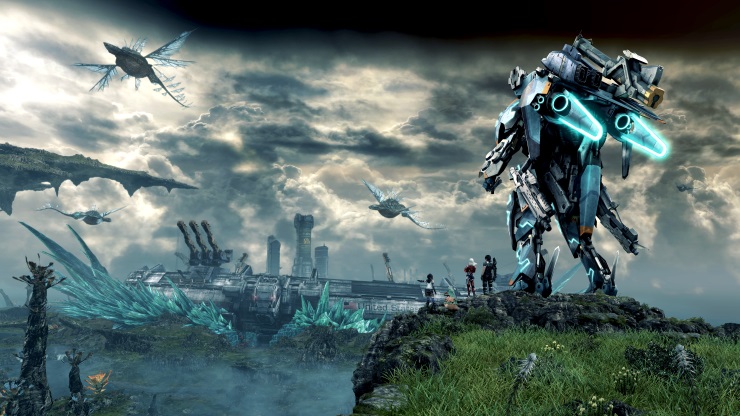December 4, 2015.
There are more than a few words I could use to describe Xenoblade Chronicles X, but “overwhelming” comes to mind as the most appropriate to describe both its strongest elements and its weakest.
The world of Mira is gigantic and intimidating in its scale, but each of its five massive continents is brimming with life and beauty. This is something that you’ll quickly discover as you engage in the main theme of exploration and survival in an alien world, hoping to help what’s left of humanity after Earth is destroyed during a battle between warring extraterrestrial factions.
As part of the exodus from Earth, gigantic ships are dispatched, carrying as much of the population as possible – many of which rest in a cryogenically frozen state. Of course, it wouldn’t be much of a game if it all ended there, so in mankind’s worst string of luck, many of these ships are shot down by aliens, with one in particular, the White Whale, crash landing on Mira, while the frozen humans are scattered across the land in escape pods known as Lifeholds. You are one of the these frozen survivors, thawed out and enlisted as a member of BLADE (Builders of the Legacy After the Destruction of Earth), a military organisation that is in charge of ensuring the exploration and colonisation of Mira.

And it’s a world you’ll learn to love. It’s unfortunate that this year saw the release of The Witcher III: Wild Hunt and Fallout 4, two games that featured such marvelous examples of living, breathing worlds, as Xenoblade Chronicles X is likely to be largely ignored when most people talk of open world excellence this year. That’s going to be unfair, because while Mira is lacking in memorable landmarks and set pieces, it’s a beautiful place to explore; with lush fields, magnificent waterfalls, overgrown rainforest and arid deserts. Whether you’re swimming through the lakes of Primordia as the rain showers down, admiring the beauty of a gigantic flying beast sailing through the sky under moonlight, or simply watching the sunset over the canyons of Oblivia, this is one of the prettiest games on the Wii U. The environments are far from flat as well, with hidden caves to be found, and almost impossible floating landmasses in the distance, which, when climbed, afford a breathtaking view.
You’ll likely be far too busy to savour these things however, as there’s an absolute ton of things to do. If I told you that there were only 12 main story missions, you’d assume that there was little content to this game. You are very much wrong. Even if you were to ignore the many side missions given to you by NPCs and the quest bulletin board, as well as the more narrative-based Affinity quests that help you learn a little more about the cast of characters you come into contact with – each Story mission has prerequisites you need to complete before you can even think of tackling them. Some might suggest a minimum level you need to be at, while others require you do have surveyed a percentage of each of the game’s five continents, or have finished specific Affinity missions, some of which you have to actively look for as they don’t show up on your map straight away. There are some people out there that might suggest that this is all filler content to stop you from finishing the game too quickly, and to a certain extent, it might well be – but I’ve been having far too much fun to care.
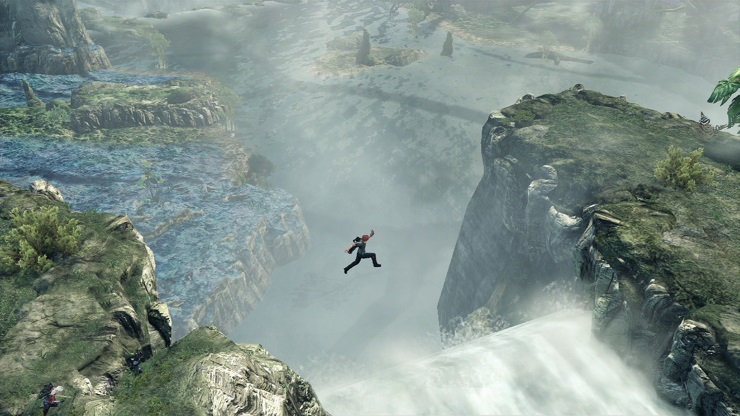
You see, Xenoblade Chronicles X is a game to be slowly enjoyed; like a fine wine, or a really tasty bag of posh crisps. There are so many mechanics and systems to delve into, it’s easy to get incredibly distracted by a random sidequest, locating and installing Data Probes to mine for precious materials and currency, or even investing in the companies that make your weapons and armour, to get better equipment. While the narrative is your typical JRPG affair (which, depending on your viewpoint, is either a good or bad thing), the dialogue is quirky and amusing enough to make you want to talk to everyone and finish as many missions as you can, just to learn more about everyday life in New Los Angeles, a colony created from the wreckage of the White Whale.
In the pursuit of completing missions, you’re going to have to get your hands dirty, and those who are familiar with the original Xenoblade Chronicles’ combat system will feel immediately at home, as it’s very similar, albeit with a few added elements. The auto-attack based fighting, and Arts, return, but you now have the ability to wield both a long range and short range weapon, which can be flipped between by a simple press of the X button. Several different weapon combinations are available, dictated by several classes you can freely swap between, which also have their own leveling system. Ranking up these classes will unlock even more Arts and attacks, and as before, you can upgrade these Arts to make them more powerful. The MMO-inspired battle system still works as well as it did in the previous game, and the new additions keep things fresh for returning players.
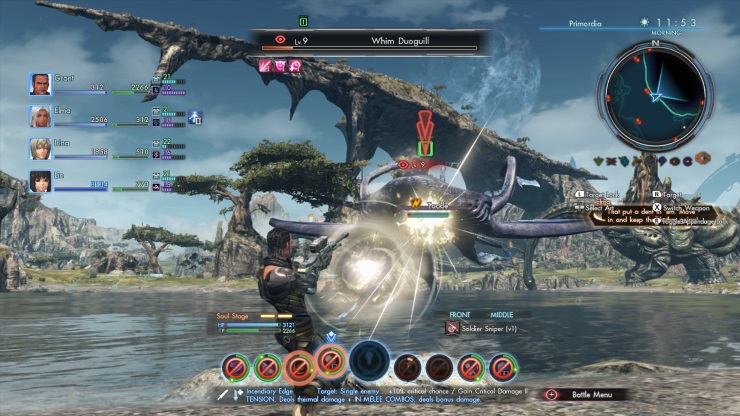
Combat isn’t perfect, however. While battles are fast-paced and action-packed, they can last a little too long, as foes leveled far lower than you can take a little too much time to kill. As a result, sometimes you just want to run past enemies to save a time (and that is sometimes a necessary option, although some creatures or enemies will actively attack you if they see you or hear you nearby, indicated by easily-seen icons). Even with a party of four, some of these enemies are damage sponges, which can be a little frustrating when you just want to get to a mission objective. There are also quite a few instances where enemies of varying difficulties are placed in areas, so it’s more than likely that you’ll have to sneak past some very high leveled enemies, just to get to the destination of a mission appropriate for your level. When you die, you’re taken back to the nearest landmark or fast travel location, which can be quite a way away if you haven’t approached one in a while.
There’s also an interesting system called Soul Voices. During a battle, either your character or a party member may say a phrase, which will cause one or more of your Arts to be highlighted in orange. Activate the highlighted Arts at the time, and they’ll activate various additional bonuses, including healing you and your party, or sometimes be prompted to additionally press B in a quicktime event for additional bonuses. It takes a little bit of time to understand and get used to, but with no specific Cure spells in your arsenal, it’s a great way to heal your party and keep them fighting. You can customise some of these phrases yourself, giving you access to a few easy combat bonuses or buffs.
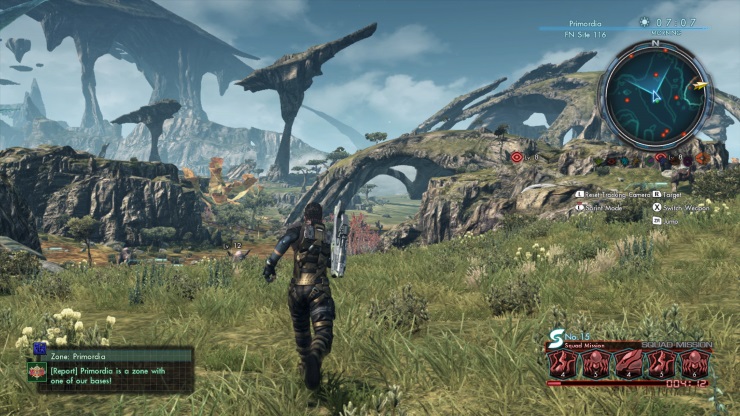
But that’s just a smaller part of a whole heap of customisation options available throughout. From the very beginning, you can completely customise the appearance or your character, including your voice, which has a lot of options to choose from, including one that is similar to Shulk’s voice from the original game. All of your equipped armour and weapons make a cosmetic difference to your character, which also takes effect in cutscenes – always a cool touch in a JRPG.
Which brings me to Skells, those gigantic mechs that you may have seen. These badass-looking titans are Xenoblade Chronicles X’s most awesome addition, but you won’t get anywhere near piloting one until at least around 25 hours into the game. They’re worth it though, not only transforming into different vehicles, allowing you easier traversal through Mira’s five continents, but they also allow you to absolutely crush enemies. However, they’re not invulnerable, and have a finite amount of fuel (which thankfully replenishes when you aren’t in the pilot seat). You can acquire multiple Skell frames and customise them until your heart’s content, changing their colour (mine is coloured to look like Metroid’s Samus Aran), weapons and armour. Meanwhile, you’re given Skell “Insurance”, which are like extra lives for your mech – once they run out, you’ll be paying through the nose to salvage your wrecked unit. It’s in your interest to keep an eye on your Skell’s energy and be ready to get out of that thing before it’s totalled.
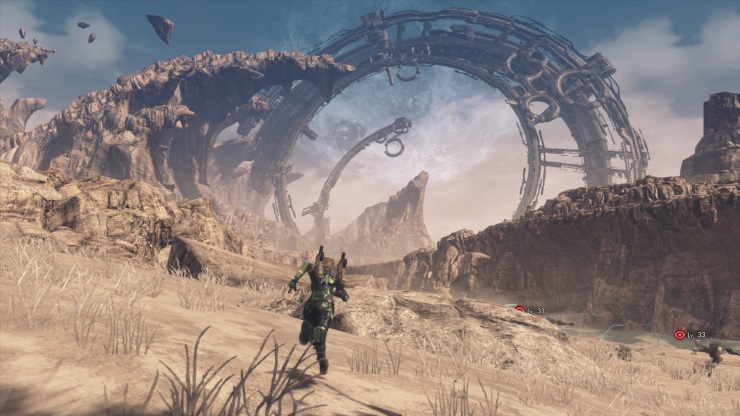
Often, there’s so much going on that you aren’t given good explanations of how to do everything, and it’s very easy to forget certain mechanics – I had largely forgotten the existence of the Follow Ball, a glowing sphere you can deploy that shows the way to your mission objective. I also experienced some issues with quests that involved gathering specific items or defeating particular enemies. You’ll be given an idea of what continent these things are on, but not always a specific location, and it can be a nightmare to find some of them, especially when a mission requires you to find a rare drop. I had to consult a Google-translated Japanese guide at times to find the locations of some things, after hours of searching massive locations. It’s even worse when these hard to find items are part of an Affinity Quest – a mission that once entered, stops you from making any story progress until completed, and can’t be abandoned either.
Another minor annoyance is the size of the UI text, which was quite small for my eyes, even on a 48” television. Playing the game on the GamePad screen was even worse. Also, regarding the Gamepad play, it’s a bit fiddly having to access the all-important map while playing in this mode, as you actually have to switch between on-TV and on-Gamepad play when you want to see the map. But it’s easily switched by just tapping on the Gamepad screen and then the icon for swapping displays. For some reason, all menus only respond to the D-Pad, not the analog stick, which is just puzzling.
In terms of the online functionality, a few of the more interesting-sounding aspects were locked in the review copy. It appears that it’s possible to send and receive scouting reports via Miiverse, which sounds very fun and useful. 4-player co-op was available, but is also a little confusing, and from my experience, seems limited to “Kill x number of monsters” type of missions. It is also possible to recruit AI versions of other characters into your party, which is also quite cool. I even spotted avatars of some members of my Friends List that are reviewing this game for other outlets, hanging around New Los Angeles.
There’s a nice mix of orchestral backing tracks on the OST, in addition to some guitar-driven rock tunes and the occasional vocal/rap track. There are some great pieces here, and the soundtrack in general is not too annoying upon repetition, which is good, considering how often you’ll hear the battle themes in particular. You can also expect vocal dialogue during cutscenes, and the delivery is comparable with other examples of the JRPG genre. However, the irritating trope of characters shouting the names of their attacks rears its ugly head, and it can be incredibly annoying to hear “TOOOOORNADO BLADE!” every few seconds.
I have enjoyed Xenoblade Chronicles X so much that I am planning to start it all over again from the beginning, so I can really take my time with this absolutely gargantuan adventure, and I rarely feel that way about any game, let alone one I’ve been playing almost non-stop for a month. This is an essential purchase for all Wii U owners who love the JRPG genre.
A massive amount of things to see and do.
Beautiful environments.
Skells are incredibly awesome to use.
Even the weakest of enemies take too long to kill.
The scale can be overwhelming at times.
Some quests feel like filler content.
So enjoyable that I'm going to start it all over again. This is an essential purchase for all Wii U owners who love the JRPG genre.


